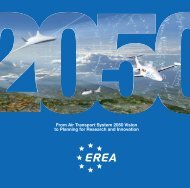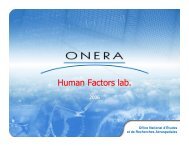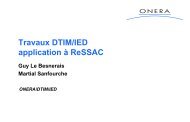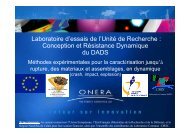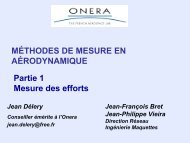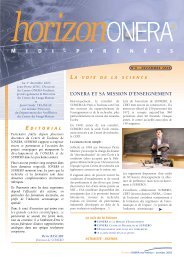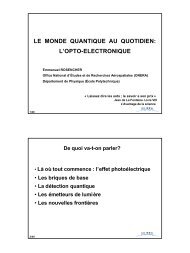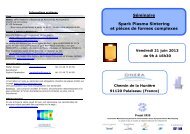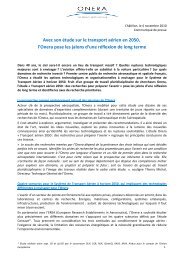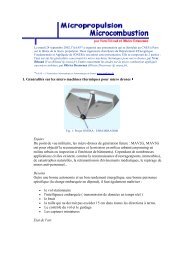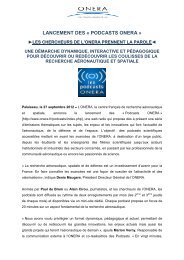electric propulsion systems of the spacecraft - Onera
electric propulsion systems of the spacecraft - Onera
electric propulsion systems of the spacecraft - Onera
Create successful ePaper yourself
Turn your PDF publications into a flip-book with our unique Google optimized e-Paper software.
1. Introduction<br />
Sophistication <strong>of</strong> <strong>the</strong> tasks solved in space<br />
requires increasing <strong>the</strong> fraction <strong>of</strong> payload in a<br />
<strong>spacecraft</strong> structure and growth <strong>of</strong> active<br />
operation lifetime (AOL). Propellant reserve<br />
required for solving long tasks substantially<br />
decreases a fraction <strong>of</strong> payload, so <strong>the</strong> main<br />
direction in updating <strong>of</strong> SC thrusters is a rise<br />
in specific impulse.<br />
Traditional liquid rocket engines <strong>of</strong> low<br />
thrust (LT LRE) provide <strong>the</strong> specific impulse<br />
no higher than 300 s with no reserve for<br />
increasing. With a rise <strong>of</strong> AOL from 10 to 15<br />
years for a geostationary SC with a mass <strong>of</strong> 2<br />
tons, <strong>the</strong> <strong>propulsion</strong> system (PS) mass fraction<br />
increases from 25…30% up to 40…45%. So,<br />
about a half <strong>of</strong> mass <strong>of</strong> a geostationary<br />
<strong>spacecraft</strong> with LT LRE, having a 15 year<br />
AOL, will fall to <strong>the</strong> share <strong>of</strong> <strong>the</strong> PS.<br />
The situation changes radically at using<br />
<strong>electric</strong> <strong>propulsion</strong>. In that case it is possible to<br />
realize propellant efflux velocity up to 30,000<br />
m/s and higher and, consequently, to make too<br />
high-economic engines. Use <strong>of</strong> <strong>electric</strong><br />
EUROPEAN CONFERENCE FOR AEROSPACE SCIENCES (EUCASS)<br />
ELECTRIC PROPULSION SYSTEMS OF THE SPACECRAFT:<br />
THE STATE-OF-THE ART IN DEVELOPMENT<br />
AND OUTLOOKS FOR PROGRESS<br />
A.I. Vasin, O.A. Gorshkov, V.A. Muravlev, A.A. Shagayda<br />
Keldysh Research Center, Moscow, Russia<br />
<strong>propulsion</strong> <strong>systems</strong> (EPS) providing a specific<br />
impulse from 1500 to 3000 s in <strong>the</strong> structure <strong>of</strong><br />
PS for orbit correction <strong>of</strong> a geostationary SC<br />
with AOL <strong>of</strong> 10 to 15 years substantially<br />
decreases <strong>the</strong> required propellant reserves.<br />
Mass saving in case <strong>of</strong> transition from LT LRE<br />
to EP will be hundreds <strong>of</strong> kg for a long-life<br />
SC.<br />
The required specific impulse for most <strong>of</strong><br />
<strong>the</strong> up-to-date applications having a practical<br />
value is 1000…3000 s. Among all <strong>the</strong> known<br />
engine types – resistojets, arcjets, pulsed<br />
plasma, magnetoplasmadynamic, Hall-type<br />
with closed electron drift (stationary plasma<br />
thrusters (SPT) and thrusters with anode layer)<br />
and ion thrusters (IT), <strong>the</strong> mostly favorable for<br />
this range <strong>of</strong> specific impulse are Hall-type<br />
and ion thrusters. Therefore <strong>the</strong> current state<br />
and prospective <strong>spacecraft</strong> applications <strong>of</strong> <strong>the</strong><br />
Xenon utilizing Hall-type and ion thrusters are<br />
discussed bellow.<br />
The analysis <strong>of</strong> efficiency <strong>of</strong> EPS<br />
application incorporated in <strong>the</strong> motion control<br />
<strong>systems</strong> <strong>of</strong> <strong>the</strong> orbital SC reveals that <strong>the</strong> most
SESSION 5.10: IN-SPACE: ELECTRIC PROPULSON<br />
reasonable fields <strong>of</strong> EPS application are as<br />
follows:<br />
• drag compensation <strong>of</strong> low-orbit SC;<br />
• transfer from low reference orbit to high<br />
reference orbit;<br />
• orbit raising and placement <strong>of</strong> satellites<br />
into orbital positions specified for <strong>the</strong><br />
given constellation;<br />
• compensation for disturbances <strong>of</strong> orbital<br />
parameters, stipulated by gravitational<br />
forces, solar pressure etc;<br />
• SC removal from <strong>the</strong> orbit in case <strong>of</strong> a<br />
failure or spent service life.<br />
Besides, at <strong>the</strong> present time, Hall-type and<br />
ion thrusters start to be used as cruise engines<br />
for fulfillment <strong>of</strong> transport operations both in<br />
near-Earth<br />
missions.<br />
space and on interplanetary<br />
A brief review <strong>of</strong> state-<strong>of</strong>-<strong>the</strong>-art in<br />
development and application <strong>of</strong> Hall-type and<br />
ion thrusters in Russia and <strong>the</strong> rest <strong>of</strong> <strong>the</strong><br />
world is given in <strong>the</strong> second section <strong>of</strong> <strong>the</strong><br />
article. The lines <strong>of</strong> fur<strong>the</strong>r development for<br />
thrusters <strong>of</strong> <strong>the</strong> noted types are presented in <strong>the</strong><br />
third section. KeRC activities on high specific<br />
impulse EP are considered in <strong>the</strong> fourth<br />
section.<br />
2. State-<strong>of</strong>-<strong>the</strong>-art in application <strong>of</strong> EP in<br />
Russia and <strong>the</strong> world<br />
Active researches <strong>of</strong> EP were started in<br />
Russia more than 40 years ago by many<br />
organizations. The greatest success was<br />
achieved in development and practical use <strong>of</strong><br />
stationary plasma thrusters.<br />
The EPS based on SPT-class thrusters<br />
found a practical use on Russian SC. The first<br />
flight tests <strong>of</strong> <strong>the</strong> SPT in Russia still took place<br />
in <strong>the</strong> seventies. A standard usage <strong>of</strong> SPT-type<br />
serial thrusters started in 1982, when <strong>the</strong><br />
thrusters SPT-70 with nominal power <strong>of</strong> 660<br />
W and thrust <strong>of</strong> 40 mN were used for orbit<br />
correction in longitude (in <strong>the</strong> direction “East-<br />
2<br />
West”) <strong>of</strong> <strong>the</strong> geostationary SC “Potok”. Later<br />
SPT-70 thrusters were also used as part <strong>of</strong> EPS<br />
for <strong>the</strong> SC “Luch”, “Luch-2”, “Kupon”,<br />
“Yamal-100”, “Yamal-200” [1].<br />
Since 1994, SPT-100 with <strong>the</strong> nominal<br />
power <strong>of</strong> 1.35 kW and thrust <strong>of</strong> 85 mN have<br />
been used as a part <strong>of</strong> EPS <strong>of</strong> <strong>the</strong> geostationary<br />
SCs “Gals”, ”Express”, “Express-A”,<br />
“SESAT” and “Express-AM” for correction <strong>of</strong><br />
both longitude and inclination (in <strong>the</strong> direction<br />
“North-South”) [1].<br />
The SPT-70 and SPT-100 thrusters were<br />
developed by EDB “Fakel”. Besides, in <strong>the</strong><br />
recent time a Hall thruster KM-5 developed by<br />
KeRC is undergoing flight tests aboard <strong>the</strong><br />
geostationary SC “Express-A” #4 developed<br />
by NPO PM. The thruster is designed to<br />
operate at nominal power <strong>of</strong> 2 kW (thrust –<br />
115 mN, specific impulse – 1850 s) and is<br />
capable to function at augmented power <strong>of</strong> 2.5<br />
kW and de-rated power <strong>of</strong> 1.35 kW. The<br />
<strong>spacecraft</strong> with <strong>the</strong> KM-5 thruster onboard was<br />
launched in June 2002 with a “Proton” rocket.<br />
At <strong>the</strong> present time, leading space states<br />
in <strong>the</strong> wake <strong>of</strong> Russia proceed to <strong>the</strong> practical<br />
application <strong>of</strong> Russian Hall thrusters in <strong>the</strong>ir<br />
SC. So, in 2002 it was made an attempt to<br />
place two geostationary SCs “STENTOR”<br />
(French Space Agency) [2] and “ASTRA-1K”<br />
(Alcatel Space) with <strong>the</strong> SPT-100 aboard to an<br />
orbit. Both <strong>spacecraft</strong>s were lost because <strong>of</strong> a<br />
launch vehicle failure.<br />
In 2003, <strong>the</strong> European Space Agency<br />
launched <strong>the</strong> <strong>spacecraft</strong> SMART-1 towards<br />
Moon. A Hall thruster PPS-1350 with nominal<br />
thrust <strong>of</strong> 68 mN is used as a cruise engine <strong>of</strong><br />
<strong>the</strong> <strong>spacecraft</strong>. Development <strong>of</strong> this thruster is<br />
a result <strong>of</strong> combined efforts <strong>of</strong> EDB “Fakel”<br />
and SNECMA (France).<br />
Several Western SC with Russian SPT-<br />
100 thrusters onboard were launched within<br />
<strong>the</strong> year 2004. Among <strong>the</strong>m two geostationary<br />
SC – IntelSat-10-2 (Eurostar 3000 platform<br />
developed by EADS Astrium) and Telstar-18<br />
(LS-1300 platform developed by Space
A.I.Vasin, O.A.Gorshkov, V.A.Muravlev, A.A.Shagayda. ELECTRIC PROPULSION SYSTEMS<br />
OF THE SPACECRAFT: THE STATE-OF-THE ART IN DEVELOPMENT AND OUTLOOKS<br />
FOR PROGRESS.<br />
Systems Loral), both launched in June 2004.<br />
Ano<strong>the</strong>r one is Amazonas (Eurostar 3000<br />
platform, EADS Astrium), launched in<br />
August. A <strong>spacecraft</strong> AMC-12/WorldSat-2<br />
(Spacebus 4000C3 platform, Alcatel Space)<br />
was launched in February 2005. Ano<strong>the</strong>r<br />
<strong>spacecraft</strong>, Inmarsat-4/F1 (Eurostar 3000<br />
platform, EADS Astrium) was launched in<br />
March 2005.<br />
Practical use <strong>of</strong> ion thrusters was initiated<br />
in 1997, when USA launched PAS-5 and<br />
Galaxy-8i communication <strong>spacecraft</strong>s, based<br />
on <strong>the</strong> platform BSS-601HP by Boeing<br />
Satellite Systems Company with ion thrusters<br />
XIPS-13. In 2000, <strong>the</strong> Galaxy-11 satellite on<br />
<strong>the</strong> platform BSS-702 equipped with <strong>the</strong><br />
second-generation IT XIPS-25 with 4.5 kW <strong>of</strong><br />
power was launched, where for <strong>the</strong> first time a<br />
PS with IT was aimed not only for orbit<br />
correction, but also for carrying out<br />
interorbital transfers during SC orbit<br />
placement. A <strong>spacecraft</strong> Deep Space-1<br />
intended for exploration <strong>of</strong> 19P/Borrelly comet<br />
was launched in 1998 by <strong>the</strong> USA. A 30-cm<br />
xenon ion thruster XIPS-30 with 2.3 kW <strong>of</strong><br />
power and 92 mN <strong>of</strong> nominal thrust, whose<br />
development was conducted at <strong>the</strong> Lewis<br />
Center, later - at Hughes and JPL companies,<br />
had operated as a cruise engine during 16,265<br />
hours [3].<br />
In Europe an EPS named RITA was used<br />
in 1992 aboard a low-orbit research platform<br />
EURECA for a flight test <strong>of</strong> RIT-10 IT with<br />
radi<strong>of</strong>requency ionization, developed in<br />
Germany. In <strong>the</strong> year 2001 RIT-10 (EADS<br />
Astrium, Germany) and UK-10 IT with<br />
electron bombardment (EADS Astrium, Great<br />
Britain) were launched to an orbit toge<strong>the</strong>r<br />
within an EPS <strong>of</strong> an experimental<br />
geostationary communication SC Artemis [4].<br />
Ion thrusters developed and made in Japan<br />
successfully operated on experimental<br />
geostationary SCs ETS-3, ETS-4 and<br />
COMETS, launched in 1982, 1994 and 1998<br />
respectively. In 2003 an interplanetary SC<br />
MUSES-C was launched where <strong>the</strong> 10-cm<br />
3<br />
microwave IT IES developed by <strong>the</strong> Institute<br />
<strong>of</strong> Space and Astronautical Science (ISAS) at<br />
0.4 kW <strong>of</strong> power is used [5].<br />
Thus, widening <strong>the</strong> field <strong>of</strong> application <strong>of</strong><br />
<strong>electric</strong> <strong>propulsion</strong> on <strong>spacecraft</strong>s is one <strong>of</strong> <strong>the</strong><br />
leading and regular tendencies on <strong>the</strong> present<br />
stage <strong>of</strong> space activities in <strong>the</strong> world.<br />
3. The main lines <strong>of</strong> prospective Hall and<br />
Ion thrusters development<br />
Fur<strong>the</strong>r improvements <strong>of</strong> Hall thrusters<br />
are associate with modern trends in SC<br />
development, such as <strong>the</strong> growth <strong>of</strong> power-toweight<br />
ratio and increase <strong>of</strong> AOL, urge<br />
towards enlargement <strong>of</strong> payload fraction in a<br />
<strong>spacecraft</strong> structure, widening <strong>of</strong> SC mass<br />
range, including low weight-size SC and<br />
heavy satellite platforms, rise <strong>of</strong> EPS task<br />
complexity, growth <strong>of</strong> demands on efficiency,<br />
reliability and SC system compatibility. All<br />
<strong>the</strong> aforementioned stimulates development <strong>of</strong><br />
new generation Hall thrusters, having <strong>the</strong><br />
following main features:<br />
• increased specific impulse (up to<br />
•<br />
2500…3000 s);<br />
capability to operate efficiently in a wide<br />
range <strong>of</strong> consumed power magnitudes,<br />
from low (50 or less…100 W) to high (up<br />
to 50 kW and above per unit thruster);<br />
• increased service life <strong>of</strong> continuous<br />
operation (for some applications it is to be<br />
up to <strong>the</strong> values in range <strong>of</strong> 8000… 10000<br />
hours and above);<br />
• decreased angular divergence <strong>of</strong> a plume<br />
that’s important to reduce <strong>the</strong> influence on<br />
SC members;<br />
The following key problems are to be solved<br />
while developing new generation hall<br />
thrusters:<br />
• to find out <strong>the</strong> main regularities <strong>of</strong><br />
acceleration channel and magnetic system<br />
pr<strong>of</strong>iling that would allow to reach high<br />
efficiency and extended lifetime for a<br />
thruster operating in a range <strong>of</strong> discharge<br />
voltage values up to 1000 V;
SESSION 5.10: IN-SPACE: ELECTRIC PROPULSON<br />
• to increase <strong>the</strong> performance <strong>of</strong> low-power<br />
thrusters;<br />
• to determine <strong>the</strong> conditions <strong>of</strong> highperformance<br />
functioning for <strong>the</strong> same<br />
thruster at different power and discharge<br />
voltage levels with lifetime retaining;<br />
• to develop <strong>the</strong> trustworthy methods for<br />
accelerated life tests, that is useful for cost<br />
and time reduction;<br />
• to search for wearpro<strong>of</strong> structural<br />
materials, maintaining prolonged operation<br />
with a high level <strong>of</strong> performance.<br />
As for <strong>the</strong> prospective ion thrusters, that<br />
are mainly considered as a solution to be used<br />
for interplanetary mission, one can mention<br />
<strong>the</strong> following lines <strong>of</strong> development:<br />
• rise <strong>of</strong> <strong>the</strong> specific unit power up to 50 kW<br />
and above;<br />
• rise <strong>of</strong> active operation time that can<br />
amount to tens <strong>of</strong> thousand hours;<br />
• search for cheaper than Xenon propellants,<br />
sustaining high thruster performance.<br />
The main EP developers in Russia and<br />
abroad are recently solving <strong>the</strong> aforementioned<br />
problems.<br />
4. KeRC activities in <strong>the</strong> field <strong>of</strong> EP<br />
Today, <strong>the</strong> active works on <strong>the</strong> subject <strong>of</strong><br />
EP are underway at KeRC. The activities<br />
include research and development (R&D) as<br />
well as <strong>the</strong> creation <strong>of</strong> thruster flight models.<br />
The emphasis is made on development <strong>of</strong> Hall<br />
thrusters.<br />
4.1. Hall thrusters<br />
Main purpose <strong>of</strong> <strong>the</strong> new generation Hall<br />
thruster development program is to solve <strong>the</strong><br />
key problems marked in <strong>the</strong> chapter 3.<br />
Two laboratory hall thrusters with high<br />
specific impulse are developed at KeRC in <strong>the</strong><br />
course <strong>of</strong> high specific impulse Hall thruster<br />
magnetic optimization activities. These<br />
thrusters operate at nominal power <strong>of</strong> 900 W<br />
and 2000 W, respectively. The operation<br />
voltage can be up to 1000 V. Both thrusters<br />
4<br />
have an enhanced capability for magnetic field<br />
topology transformation. Design <strong>of</strong> <strong>the</strong><br />
thrusters includes four coaxial magnetic coils<br />
and a set <strong>of</strong> coaxial magnetic screens. The<br />
magnetic system allows changing <strong>the</strong> axial and<br />
radial position <strong>of</strong> plasma lens and <strong>the</strong> shape <strong>of</strong><br />
magnetic field lines by varying current ratio in<br />
<strong>the</strong> coils during an experiment. To investigate<br />
<strong>the</strong> influence <strong>of</strong> magnetic lens topology on <strong>the</strong><br />
structure and position <strong>of</strong> <strong>the</strong> accelerating layer<br />
<strong>the</strong> thruster is equipped with a set <strong>of</strong> near-wall<br />
Langmuir probes. The probes are placed in <strong>the</strong><br />
external ceramic wall <strong>of</strong> discharge chamber.<br />
The recent experiments are performed on <strong>the</strong><br />
900 W model. The purpose <strong>of</strong> <strong>the</strong> experiments<br />
is to study <strong>the</strong> influence <strong>of</strong> magnetic field<br />
parameters onto <strong>the</strong> thrust, specific impulse,<br />
efficiency, propellant utilization coefficient,<br />
ion to electron current ratio, average ion<br />
energy, length and position <strong>of</strong> <strong>the</strong> acceleration<br />
layer. Two variants <strong>of</strong> magnetic field topology<br />
that differ in <strong>the</strong> inclination <strong>of</strong> magnetic field<br />
lines with respect <strong>the</strong> thruster axis are shown<br />
in figure 1.<br />
Fig.1
A.I.Vasin, O.A.Gorshkov, V.A.Muravlev, A.A.Shagayda. ELECTRIC PROPULSION SYSTEMS<br />
OF THE SPACECRAFT: THE STATE-OF-THE ART IN DEVELOPMENT AND OUTLOOKS<br />
FOR PROGRESS.<br />
Ano<strong>the</strong>r field <strong>of</strong> research is associated<br />
with searching for <strong>the</strong> optimal design <strong>of</strong> a high<br />
voltage HET channel.<br />
For this purpose studies <strong>of</strong> performance<br />
and local parameters in <strong>the</strong> channel <strong>of</strong> a<br />
laboratory Hall thruster with nominal power <strong>of</strong><br />
700 W are carried out on different designs <strong>of</strong><br />
<strong>the</strong> discharge channel exit part. The studies are<br />
performed at various voltages in range <strong>of</strong><br />
300…600 V. The classical design <strong>of</strong> <strong>the</strong><br />
discharge chamber with cylindrical ceramic<br />
walls is compared with <strong>the</strong> hybrid design in<br />
which <strong>the</strong> basic part <strong>of</strong> <strong>the</strong> discharge chamber<br />
is made <strong>of</strong> metal, and <strong>the</strong> exit zone is equipped<br />
with ceramic rings. Design variations with<br />
different height <strong>of</strong> discharge chamber metal<br />
part and length <strong>of</strong> ceramic rings are<br />
investigated.<br />
A fully kinetic numerical model aimed for<br />
better understanding <strong>of</strong> processes in a Hall<br />
thruster discharge is under development. The<br />
model is two-dimensional in space and threedimensional<br />
in velocities and treats electrons,<br />
ions and neutrals as particles. Coulomb<br />
collisions, elastic and ionization electronneutral<br />
collisions, electron-neutrals excitation,<br />
charge-exchange and ion-wall recombination<br />
are accounted for. Electric filed is defined<br />
from Poisson’s equation. Using <strong>the</strong> model<br />
<strong>the</strong>re were obtained distributions <strong>of</strong> plasma<br />
parameters for several operational modes <strong>of</strong><br />
low power HETs developed at KeRC. An<br />
example <strong>of</strong> results <strong>of</strong> HET plasma density<br />
calculation is presented in figure 2.<br />
Fig. 2<br />
In <strong>the</strong> recent time main efforts are made to<br />
decrease <strong>the</strong> computation time and to improve<br />
<strong>the</strong> accuracy <strong>of</strong> boundary-condition modeling<br />
5<br />
and collisions simulation. It is planned to<br />
represent <strong>the</strong> results <strong>of</strong> <strong>the</strong> noted studies on <strong>the</strong><br />
International Electric Propulsion Conference<br />
that is to take place in USA, in autumn 2005.<br />
A s<strong>of</strong>tware package for modeling <strong>of</strong><br />
interaction between a plasma plume and a<br />
<strong>spacecraft</strong> is being developed for solving <strong>the</strong><br />
problems appearing in <strong>the</strong> course <strong>of</strong> <strong>electric</strong><br />
thrusters integration within a <strong>spacecraft</strong> (see<br />
fig. 3). The computations can provide data on<br />
thrust loss, misalignment angular velocity,<br />
<strong>spacecraft</strong> units overheating, changes <strong>of</strong><br />
mechanical and optical properties <strong>of</strong> <strong>spacecraft</strong><br />
external surfaces and solar panels.<br />
Fig. 3<br />
Methods <strong>of</strong> optical spectral emission<br />
diagnostics <strong>of</strong> Hall thruster plume are<br />
developing rapidly. Studies intended to<br />
measure erosion rate <strong>of</strong> Hall thruster<br />
accelerating channel using spectral methods<br />
are performed during both long-term firing life<br />
tests and working mode optimization firing<br />
tests. The experiments allowed to detect<br />
spectral emissions <strong>of</strong> thruster ceramic wall<br />
atoms and to observe a good correlation<br />
between <strong>the</strong> lines intensity and <strong>the</strong> erosion rate<br />
measured by a direct method (see fig. 4). The<br />
method <strong>of</strong> non-contact optical diagnostics may<br />
become a part <strong>of</strong> an accelerated life tests<br />
procedure. The latter can be very important for<br />
life test time and cost reduction.
SESSION 5.10: IN-SPACE: ELECTRIC PROPULSON<br />
Thrusters <strong>of</strong> different types and sizes with<br />
a power from 50 W to 6 kW have been made<br />
with a use <strong>of</strong> <strong>the</strong> mentioned research data.<br />
These are <strong>the</strong> thrusters <strong>of</strong> low power (up to 1<br />
kW) – KM-37, KM-45 [6], KM-60, <strong>the</strong> meanpower<br />
thrusters (1 to 2.5 kW) – KM-4, KM-5,<br />
KM-100 and <strong>the</strong> thrusters <strong>of</strong> high power –<br />
KM-6, KM-7. The Hall-type thrusters KM-5,<br />
KM-7 and KM-45 have been successfully<br />
subjected to qualification tests.<br />
Fig. 4<br />
Nowadays <strong>the</strong> KM-5 Hall thruster is<br />
undergoing flight tests aboard <strong>the</strong><br />
geostationary “Express-A” SC developed by<br />
NPO PM.<br />
The Hall thruster KM-45 (fig. 5), with<br />
nominal thrust <strong>of</strong> 18 mN at power 350 W is<br />
designed for small <strong>spacecraft</strong> (mass up to 500<br />
kg), e.g. “Gnom” SC.<br />
Fig. 5<br />
6<br />
A high power thruster KM-7 (3.5…6 kW,<br />
200…450 mN) is designed for orbit correction<br />
<strong>of</strong> heavy GEO SC (e.g @Bus platform<br />
developed by Alcatel Space and EADS<br />
Astrium). This thruster can also be fitted on a<br />
European space tug ConeXpress that is aimed<br />
for sustaining operability <strong>of</strong> GEO satellites<br />
with exhausted lifetime or for rescue <strong>of</strong><br />
<strong>spacecraft</strong>s with improper orbital placement.<br />
A 10 kW thruster KM-10 based on a<br />
design <strong>of</strong> T-220 thruster is being developed. It<br />
is designed for inter-orbital transport <strong>systems</strong>.<br />
Following <strong>the</strong> tendency <strong>of</strong> optimal<br />
specific impulse increase, KeRC develops<br />
KM-60 and KM-100 thrusters with enhanced<br />
specific impulse. KM-60 thruster is to be used<br />
on prospective geostationary light-weight<br />
platform. Its specific impulse at 900 W <strong>of</strong><br />
power is about 2000 s in <strong>the</strong> beginning <strong>of</strong><br />
lifetime. The development is now at <strong>the</strong><br />
engineering model stage. The environmental<br />
resistance tests are recently performed as well<br />
as <strong>the</strong> integrated firing life tests with a xenon<br />
flow control unit. Two cathodes have already<br />
passed <strong>the</strong> autonomous cycling life test. Each<br />
cathode successfully operated in course <strong>of</strong><br />
about 20000 On-<strong>of</strong>f cycles.<br />
The development <strong>of</strong> KM-100 thruster with<br />
a high specific impulse for an advanced<br />
geostationary mid-weight platform has been<br />
started. A laboratory model <strong>of</strong> <strong>the</strong> thruster is<br />
capable to operate at power <strong>of</strong> 1.5…2.5 kW<br />
with a specific impulse <strong>of</strong> 2500…3000 s.<br />
4.2. Ion thrusters<br />
The works in field <strong>of</strong> IT development<br />
are performed in cooperation with Moscow<br />
Aviation Institute. Recently <strong>the</strong> main efforts<br />
are concentrated on studies <strong>of</strong> IT using<br />
alternative propellants for interplanetary<br />
<strong>spacecraft</strong> <strong>propulsion</strong>. A 30-cm IT is used as a<br />
prototype <strong>of</strong> such thrusters. Comparative tests<br />
<strong>of</strong> <strong>the</strong> thruster were performed on Xenon,<br />
Krypton and Argon at power <strong>of</strong> 5 kW.
A.I.Vasin, O.A.Gorshkov, V.A.Muravlev, A.A.Shagayda. ELECTRIC PROPULSION SYSTEMS<br />
OF THE SPACECRAFT: THE STATE-OF-THE ART IN DEVELOPMENT AND OUTLOOKS<br />
FOR PROGRESS.<br />
4.3. Experimental and production basis<br />
KeRC has created an experimental and<br />
production basis for HET laboratory research<br />
and development, as well as for flight models<br />
manufacturing.<br />
Up-to-date test base allows research and<br />
update <strong>of</strong> thrusters with a power up to 10 kW.<br />
More than 10 experimental installations have<br />
been actuated for testing <strong>of</strong> EP, EPS and <strong>the</strong>ir<br />
members.<br />
The cryovacuum facility CVF-35 is<br />
intended for performing firing tests, including<br />
life tests <strong>of</strong> thrusters with a power <strong>of</strong> up to<br />
6 kW. The vacuum chamber <strong>of</strong> <strong>the</strong> facility has<br />
<strong>the</strong> volume <strong>of</strong> 35 m 3 and <strong>the</strong> diameter <strong>of</strong> 3 m.<br />
The total capacity <strong>of</strong> <strong>the</strong> vacuum system is 42<br />
m 3 /s for xenon.<br />
Considering <strong>the</strong> experience gained during<br />
operating <strong>the</strong> CVF-35 facility, <strong>the</strong> new big<br />
cryogenic vacuum stand CVF-90 has been put<br />
into operation for tests <strong>of</strong> high-power EP with<br />
a vacuum chamber <strong>of</strong> 90 m 3 volume. The total<br />
pumping rate after installation <strong>of</strong> all cryogenic<br />
pumps will reach 200,000 l/s (by xenon) [7].<br />
The facility allows to perform high power<br />
<strong>electric</strong> thruster life tests, as well as all types<br />
<strong>of</strong> limited firing tests and parameterization.<br />
The test stand is equipped with <strong>the</strong> plume<br />
diagnostics system that allows measurement <strong>of</strong><br />
plasma plume on operation <strong>of</strong> Hall thruster.<br />
As <strong>of</strong> <strong>the</strong> moment <strong>the</strong> stand makes it<br />
possible to conduct firing tests <strong>of</strong> Hall<br />
thrusters with a power up to 10 kW. The total<br />
capacity <strong>of</strong> pumping comprises 71,000 l/s.<br />
5. Conclusion<br />
1. The EP differ beneficially from LT LRE<br />
by <strong>the</strong> higher value <strong>of</strong> specific impulse<br />
which results in that <strong>the</strong> total mass <strong>of</strong> EP<br />
becomes less than that <strong>of</strong> chemical PS at<br />
comparable values <strong>of</strong> <strong>the</strong> total impulse. A<br />
gain due to <strong>the</strong> application <strong>of</strong> EPS grows<br />
with increasing total impulse.<br />
7<br />
2. At <strong>the</strong> present time EP are actively used<br />
both in Russia and in <strong>the</strong> world.<br />
Development <strong>of</strong> advanced SC makes<br />
creation <strong>of</strong> next-generation EP actual.<br />
3. Today, <strong>the</strong> active works on <strong>the</strong> subject <strong>of</strong><br />
EP are underway at KeRC. The activities<br />
R&D as well as <strong>the</strong> creation <strong>of</strong> thruster<br />
flight models. A family <strong>of</strong> Hall thrusters<br />
designed for operation in <strong>the</strong> range <strong>of</strong><br />
power from 50 W to 6 kW, including flight<br />
models <strong>of</strong> thrusters, has been developed.<br />
4. KeRC has its own modern test and<br />
production base allowing <strong>the</strong><br />
manufacturing <strong>of</strong> flight thrusters.<br />
References<br />
[1] V. Murashko, A. Koryakin, A. Nyatin, et al., “State<br />
<strong>of</strong> <strong>the</strong> Art and Prospects <strong>of</strong> Electric Propulsion in<br />
Russia”, IEPC-03-0322, 28 th International Electric<br />
Propulsion Conference, Toulouse, France, 17-21<br />
March 2003.<br />
[2] P. Garnero, T. Grassin, F. Darnon, L. Petitjean,<br />
“STENTOR Plasma Propulsion System<br />
Experience”, IEPC-03-048, 28 th International<br />
Electric Propulsion Conference, Toulouse, France,<br />
17-21 March 2003.<br />
[3] M.D. Rayman, “The Successful Conclusion <strong>of</strong> <strong>the</strong><br />
Deep Space 1 Mission: Important Results Without<br />
a Flashy Title”, 53 rd International Astronautical<br />
Congress/World Space Congress, 10-19 October<br />
2002, Houston, TX, IAC-02-Q.5.2.03.<br />
[4] R. Killinger, H. Gray, R. Kukies, et al.,<br />
“ARTEMIS Orbit Raising In-Flight Experience<br />
with Ion Propulsion”, IEPC-03-096, 28 th<br />
International Electric Propulsion Conference,<br />
Toulouse, France, 17-21 March 2003.<br />
[5] H. Tahara “An Overview <strong>of</strong> Electric Propulsion<br />
Activities in Japan”, IEPC-03-0339, 28 th<br />
International Electric Propulsion Conference,<br />
Toulouse, France, 17-21 March 2003.<br />
[6] M.B. Belikov, A.I. Vasin, O.A. Gorshkov, et al.,<br />
“Low-Power Hall-Effect Thruster for Small<br />
Spacecrafts”, International Symposium on Space<br />
Propulsion 2004, Shanghai, PR China, August 25-<br />
28, 2004.<br />
[7] O.A. Gorshkov, A.A. Ilyin, R.N. Rizakhanov,<br />
“New Large Facility for High-Power Electric<br />
Propulsion Tests”, 6 th International Symposium<br />
Propulsion for Space Transportation <strong>of</strong> <strong>the</strong> XXI st<br />
century, Versailles, France, 14-17 May, 2002.



